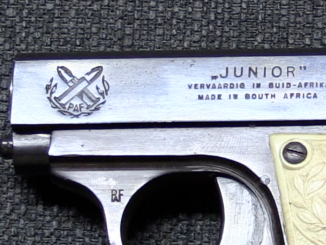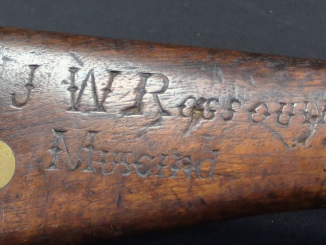In order to allow cheaper and simpler training of troops, the South African Defense Forces adopted a .22 rimfire conversion kit for their R4 rifles. The system was developed by an engineer named Willie Klotz working for Thor Engineering. It is an open-bolt firing system which is quite complex, and interestingly uses the sear of the Galil/AK fire control system to fire rather than the hammer. The conversion is rather tricky to install, and in practice often required hand-fitting each kit to a specific rifle.
Related Articles

Commentary
Overview of South African Gun Laws

Semiauto pistol
P.A.F. Junior – South Africa’s First Production Gun

Bolt Action Rifles

So much for quick and easy conversion kits. Why not build a dedicated training weapon instead if a conversion kit is too difficult to install?!
This is what Diemaco attempted at around 1990. The result was completely self-standing .22cal semi-auto rifle. Bottom receiver was combined with stock and pistol grip into single unit shot out of glass reinforced nylon. In order to facilitate possible future full-on rifle conversion, there was stainless steel recoil tube onto which mounted buttplate in usual manner. At front it was permanently connected with liner/shell which main purpose was to maintain distances between shafts of trigger mechanism. There was .22 plastic molded insert for 13shots integrated into standard 5.56 magazine. It was slick package overall.
The rifle was planned as a Training/ Cadet rifle with intended designation C10. It was made in about 2 dozens of examples and tested by Canadian forces with positive outcome. However, from what I’ve heard it never found implementation; one reason cited was a potential liability issue when in hands of army cades (basically young civilians).
E.F.Dragunov also designed .22 rim-fire self-loading training rifle, it was called ТСВ-1
https://ru.wikipedia.org/wiki/%D0%A2%D0%A1%D0%92-1
it was made in small quantity. Magazine capacity 10, overall mass 3,8 kg. It is said that at distance of 50 m experienced shooter could put 10 shots in 12 mm diameter target.
I did not mention barrel. It was dedicated .22 LR with plastic front sight base and usual set of handguards minus heat liners. The operation was by expectation blowback. I do not recall exactly at what distance it was supposed to be used, but believe it was 100 yards. That would be quite realistic; I do plinking at that distance with my own 22LR rifle using Winchester varmint ammo routinely with not exactly terrible results.
@Cherndog
Can I recommend Tom Sharp’s two S’frican novels. Riotous assembly and indecent exposure.
Sharp was expelled from apartheid era S’frica.
For about a year, my office base was where the big house in Riotous assembly was supposed to be.
Sharp’s satire is blood thirstily and totally accurate in a very non pc way. The satire is also amazingly relevant to the current united police state, and its war mongering paranoia.
[off-topic so ignore if you wish]
I know U.S. fire-arms accessory market is very wide and ranging from useful add-on, through cool-looking but given little help to virtually useless. Today I encountered yet another contraption called NOT A STOCK https://mpopenker.livejournal.com/2403561.html
Is that any useful in reality?
@Daweo
There was recently a newsflash about a novelty from Russia
https://www.thefirearmblog.com/blog/2019/01/17/vasilyev-automatic-rifle-var-concept/
It looks it was sourced from Voyennoye obozrennie (Topwar.ru). I spotted it there too, but did nor read the article. This is evidently a clean departure from conventional rifle/DMR/LMG as we know it. It involves new type of ammunition – basically dart fired from super-caliber shell via sabot.
The point of the device you linked is basically the same as the folding/telescoping stocks on B&T’s USW, the PM-63 RAK, or the vz.61 Skorpion — an effort to combine the ease of carry of a holsterable pistol with the stability of a shoulderable carbine. The “NOT A STOCK” bit is just to work around the specifics of US law (I’ll explain this in detail with a follow-up post), but in practical terms the product is definitely a stock.
As to whether it’s useful — well, I find it a very interesting idea that seems useful in a wide range of contexts, but it’s not clear how valuable it actually is in practice. Certainly the Polish and Czech militaries thought the concept of a holsterable, folding-stock weapon was useful enough to adopt in a PDW role, but it’s been half a century and barely anyone else has followed.
Then again, there’s more to life than military service — the USW is very much targeted at police, and this might have more legs there, too. I’m not sure how successful the USW may be in terms of adoption — I know it’s not very popular on the US market, but that may be due to the peculiarities of US law this product is working around (again, see followup post).
Finally, there’s sporting/utility use. Now this may seem odd, but as a rural American, I carry a pistol in my coat pocket whenever I go outside. Not for defense against murderous thugs (we really don’t have a problem with them out here in the countryside), but so that if I cross paths with a predator, I can shoot it on the spot. However, against small targets (e.g. feral cats), my practical range with a handgun is rather limited by my admittedly poor marksmanship. I’d do much better at 50 yards with the additional stability of a shoulder stock, but these encounters don’t happen often enough to justify lugging a rifle with me every day. So something like this is actually quite interesting to me.
Now I don’t believe I’ll actually buy one, as I have my own ideas about building a holsterable critter gitter more akin to the classic “bicycle rifle”, but it’s quite interesting, and if I didn’t have access to a machine shop to make/modify my own guns, I think I’d be getting one.
The idea of this whole class of non-stock items goes back to some peculiar restrictions in our gangster-era weapons law, the NFA. The original draft of this law would have restricted all handguns and concealable weapons, but this would have been wildly unpopular, so handguns were removed from it before it became law. However, the length restrictions on long guns (originally included to prevent people from using chopped long guns as handgun substitutes) remained in place.
So anything that has a shoulder stock, is classified as a rifle or shotgun. These (and any weapons made from them, e.g. by removing the shoulder stock) must have at least 26″ overall length and at least 18″ (shotgun) or 16″ (rifle) barrel length to avoid falling under NFA restrictions.
So if an American wants a compact carbine with 14.5″ barrel (like a semi-auto clone of the military’s M4), or a pistol with a shoulder stock (like the USW), he generally has to pay a $200 tax and go through a bunch of paperwork to do so. Now it’s not restricted as to who can own them — anyone legally allowed to own any firearm can file the paperwork and pay the tax to transfer an NFA-restricted firearms — but the tax, the hassle, and the federal registry strike most people as more trouble than its worth, so a manufacturer trying to sell any NFA item like a stocked handgun only reaches a small fraction of the US market.
Products like the one you mention work around the NFA by not legally being a shoulder stock — they are not designed or made for use against the shoulder, but rather to be braced against the forearm to add stability when firing one-handed, or against the cheek to facilitate sight alignment. Any utility in shouldering a firearm is, we all pretend, completely coincidental.
This is generally a big lie, of course, but as long as the brace actually has some feature(s) to increase usability against the forearm or cheek, and as long as the manufacturer isn’t stupid enough to say the truth, the pretense holds up, and allows weapons fitted with such braces to be classified as pistols, and not affected by the length restrictions on rifles.
I should clarify, the first brace on the market really was legitimately intended as an arm brace, to allow the disabled with only one usable arm to shoot rifle-caliber pistols one-handed. But there was an incredible surge of sales to able-bodied shooters based on the fact that it could be used as a stock without legally being a stock, swiftly followed by a succession of models introduced to the market whose brace nature was just a pretense.
This is first time when I read reality behind so called “braces”. My suspicion was exactly as you say. Everyone has to play the game. 🙂
Interesting to read your views Ben.
Living in rural setting must be lot more comforting for body and soul. When you say you have regularly handgun of you to deal with predators, what kind is it? And about caliber of the gun, is it something of .357 Mag and up? You’d probably make a do with 9mm, but just barely; depending on size of animal.
I’m currently carrying a polymer80 Glock clone, specifically the PF940CL — that’s the one with a full-size (G17) slide, but a compact (G19) grip and magazines.
Caliber is actually .357 SIG, just because I like it, but 9mm would be more than adequate around here; there’s nothing bigger than a coyote. In the summertime, when I don’t have a coat on, I usually carry a .22 WMR revolver. The bicycle rifle I’m planning will also be chambered for .22 WMR, or something similar.
Hi there
I enjoy your videos, thank you and keep loading them please.
I am looking for one of those R4 R5 converter to fire .22 rimfire, any ideas where to source one?
Thanks
Chris